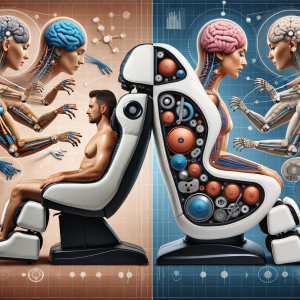From Rollers to Airbags: How Do Massage Chairs Mimic Real Masseurs?
The sensation of a skilled masseur working on your aching muscles is unparalleled. But the rise of massage chairs has many asking, ‘How do massage chairs work in replicating this human touch?’ Join us as we explore the innovations making this possible.

Bridging technology and human touch for optimal relaxation.
The Science of Touch: Understanding Human Massage Techniques
Before delving into how massage chairs replicate the human touch, it’s crucial to understand the basics of manual massage. Masseurs use various techniques, like kneading, tapping, rolling, and Shiatsu, to manipulate muscles, relieve tension, and improve blood flow. Each technique has its own unique rhythm, pressure, and motion.
Rollers: The Backbone of the Mechanical Masseur
Rollers are pivotal in mimicking the fingers and palms of masseurs:
- Precision and Pressure: Modern rollers are designed to move with precision. They can adjust the pressure to either provide deep tissue massage or gentle surface rubs, much like a human hand would.
- Varied Movements: Rollers can emulate several massage techniques by shifting direction, adjusting speed, or altering pressure.
Airbags: Emulating Compression and Squeezing
Airbags play a significant role in simulating the compression techniques used by masseurs:
- Localized Compression: By inflating and deflating, airbags squeeze specific muscle groups, enhancing blood circulation and relieving muscle stiffness.
- Sequential Inflation: Some chairs use a series of airbags that inflate and deflate in a sequence, mimicking the rhythmic hand movements of a masseur during techniques like kneading.
Heating Pads: Replicating Warm Hand Techniques
The warmth from a masseur’s hands can relax muscles, making them more receptive to massage. Chairs replicate this with strategically placed heating pads, especially in areas like the lumbar region where warmth can provide added relief.
Track Systems: Following the Natural Hand Path
Track systems ensure that the rollers follow a path resembling the hand movements of a masseur:
- S-Track: Ensures rollers follow the spine’s curvature, similar to a masseur’s hands moving down one’s back.
- L-Track: Extends the reach of rollers to areas like the thighs and glutes, areas often addressed in full-body massages.
Vibration and Pulsation: Stimulating Muscle Responses
Quick taps and rhythmic pulsations are common in massages. Massage chairs employ small vibrational motors to recreate these sensations, helping stimulate blood flow and muscle reflexes.
Advanced Sensors: Adapting to Individual Needs
Cutting-edge massage chairs come equipped with sensors that detect muscle tension and body shape. These chairs adjust their techniques in real-time, ensuring the user gets a personalized massage experience, similar to how a masseur would adapt to individual client needs.
Programmability: Learning and Adapting
Advanced chairs allow users to program and save their preferred massage routines. Over time, with regular use, some chairs can even “learn” user preferences and offer customized massage sessions, replicating the familiarity one might have with a regular masseur.
Conclusion
While the debate continues about whether machines can ever truly replace the nuanced touch of a human masseur, there’s no denying the impressive advancements in massage chair technology. By understanding and replicating various massage techniques, these chairs offer a convenient and effective alternative for those seeking relaxation and relief.